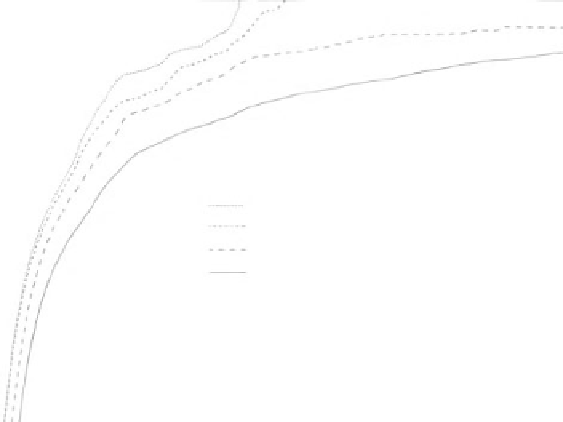Global Positioning System Reference
In-Depth Information
99.999
99.99
99.9
99
90
24 satellites with 4 GEOS
23 satellites with 4 GEOS
22 satellites with 4 GEOS
21 satellites with 4 GEOS
70
50
30
10
1
0.1
4
5
6
0
1
2
3
7
8
9
10
PDOP
Figure 7.26
Cumulative distribution of PDOP with four geostationary satellites.
by geostationary satellites. RAIM and FDE would be employed for integrity moni-
toring if the WAAS signal was unavailable from the geostationary or the user is out-
side of the WAAS service area but within the footprint of the WAAS geostationary
satellite. The three geostationary satellites visible from CONUS (POR, AORW, and
AORE) are used to augment the constellation. The analysis is again conducted for
SA on and SA off conditions. As shown in Tables 7.13 and 7.14, there is a significant
improvement in availability when the geostationary satellites are used to augment
the constellation even with SA on.
There is 100% availability of fault detection for the en route and terminal
phases of flight even without baro aiding. The availability for a nonprecision
approach increases to 99.88% with a maximum outage duration of 15 minutes.
Availability with baro aiding is 100% for all phases of flight and is not presented
here. Since the availability of FDE is much higher with use of geostationary satel-
lites, availability of FDE without baro aiding is evaluated; however, the outages
are fairly substantial for nonprecision approach, lasting up to 2 hours in duration.
Table 7.13
RAIM/FDE Availability over CONUS with a 5º
Mask Angle and Three Geostationary Satellites with SA On
Nonprecision
Approach
RAIM/FDE Function
En Route
Terminal
Fault detection
100%
100%
99.88%
Fault detection and
exclusion
99.90%
99.52%
89.37%
Fault detection and
exclusion with
baro aiding
100%
99.91%
98.13%



Search WWH ::

Custom Search